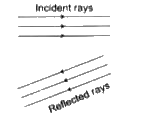In a regular reflection, the incident parallel rays have ____.
a large angle of incidence
a small angle of incidence
different angle of incidence
equal angle of incidence
The correct Answer is:D
To answer the question "In a regular reflection, the incident parallel rays have ____," we can follow these steps:
1. Understanding Regular Reflection: Regular reflection occurs when light rays strike a smooth and polished surface, such as a plane mirror. This type of reflection allows for the clear and defined reflection of light.
2. Identifying the Incident Rays: In this scenario, we are considering incident rays that are parallel to each other. This means that the rays are coming in at the same angle and direction towards the reflective surface.
3. Drawing the Normal Line: For each incident ray, we can draw a normal line at the point where the ray strikes the surface. The normal line is perpendicular to the surface at that point.
4. Angle of Incidence: The angle of incidence is defined as the angle between the incident ray and the normal line. Since the rays are parallel, they will all have the same angle of incidence when they strike the surface.
5. Conclusion: Therefore, in regular reflection, the incident parallel rays have equal angles of incidence. This means that all the parallel rays will reflect off the surface at the same angle, maintaining their parallel nature after reflection.
Final Answer:
In a regular reflection, the incident parallel rays have equal angles of incidence.
---
In a regular reflection, the incident parallel rays have equal angles of incidence.
Topper's Solved these Questions
- LIGHTBOOK - PEARSON IIT JEE FOUNDATIONCHAPTER - LIGHTEXERCISE - CLASSROOM CORNER (C. Long Answer Type Questions )
15 Videos
- KINEMATICS BOOK - PEARSON IIT JEE FOUNDATIONCHAPTER - KINEMATICS EXERCISE - CONCEPT APPLICATION (Level 3) (Application Based Questions )
5 Videos
- MAGNETISM BOOK - PEARSON IIT JEE FOUNDATIONCHAPTER - MAGNETISM EXERCISE - CONCEPT APPLICATION (Level 3)
4 Videos
Similar Questions
Draw ray diagram in each of the following cases to show what happens atfer reflection to the incident ray when
it is parallel to the principal axis and falling on a convex mirror.
View SolutionThe mirrors are perpendicular to each other as shown in the Fig. A light ray AB is incident on the mirror M1. Then the reflected ray will also suffer a reflection from the mirror M2). Then the final ray after reflection from M2 will be parallel to the incident ray, if -

View Solution
Knowledge Check
What are the laws of reflection?
(i) The angle of incidence is equal to the angle of reflection, and
(ii) The incident ray, the normal to the mirror at the point of incidence and the reflected ray, all lie in the same plane.
(iii) Incident ray is equal to emergent ray.
(iv) Reflected ray is equal to emergent ray.A(i) and (ii)B(i) and (iv)C(i), (ii) and (iv)DAll the aboveFigure shows parallel rays incident on a mirror. They are reflected as parallel rays. What is the nature of the mirror?
 APlaneBConcaveCConvexDParabolic
APlaneBConcaveCConvexDParabolicWhich one of the following is the correct angle between the
incident and reflected rays when a ray of light incident
normally on a plane mirror?Aa 180∘Bb 90∘Cc 45∘Dd 0∘
A ray of light intensity I is incident on a parallel glass-slab at a point A as shown in figure. It undergoes partial reflection and refraction. At each reflection 25% of incident energy is reflected. The rays AB and A′B′ undergo interference. The ratio Imax/Imin is

View SolutionA ray of light intensity I is incident on a parallel glass-slab at a point A as shown in figure. It undergoes partial reflection and refraction. At each reflection 25% of incident energy is reflected. The rays AB and A′B′ undergo interference. The ratio Imax/Imin is

View SolutionA ray of light incident on a glass sphere (refractive index √3 ) suffers total internal reflection before emerging out exactly parallel to the incident ray. The angle of incidence was
View SolutionIn a plain mirror the angle between the incident ray and reflected ray is 60∘ . The angle between incident ray and mirror is?
View SolutionA ray of light incident on a plane mirror at an angle θ. If the angle between the incident and reflected rays is 80∘, what is the value of θ?
View Solution
